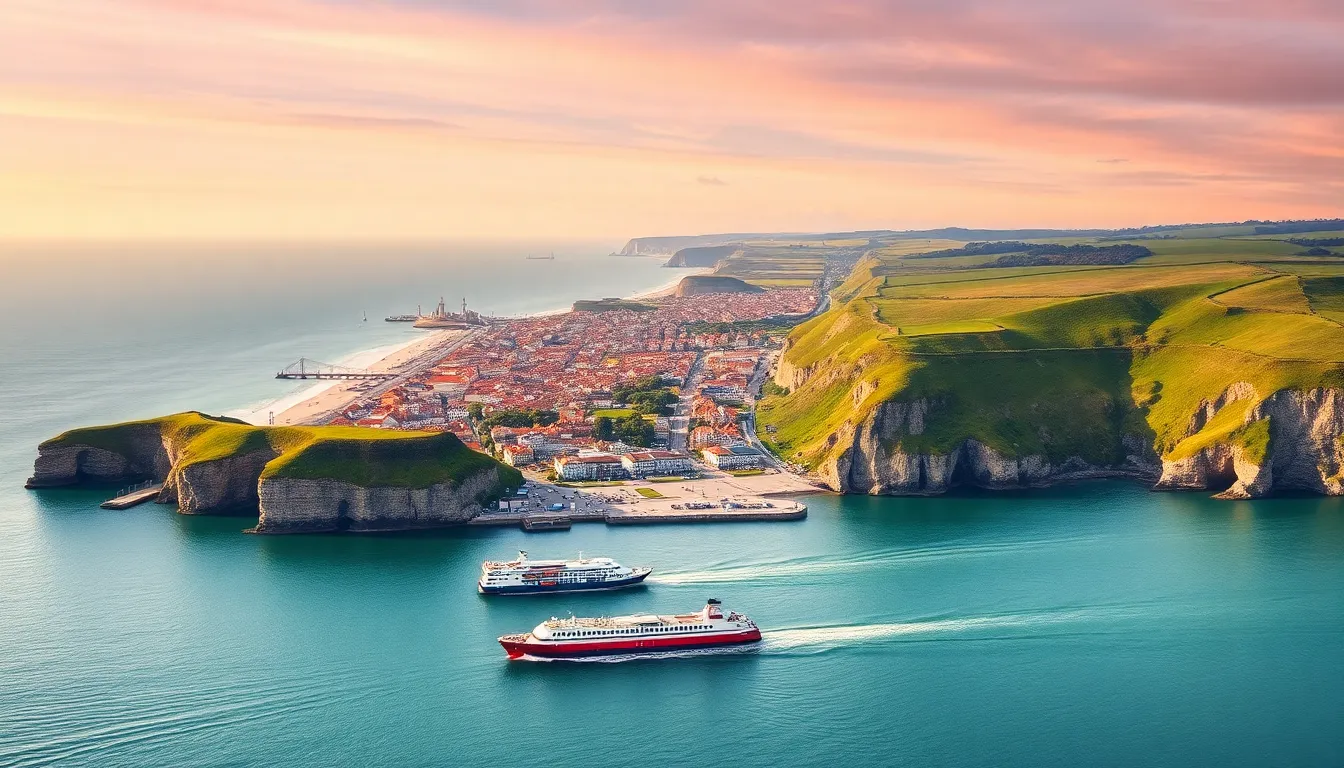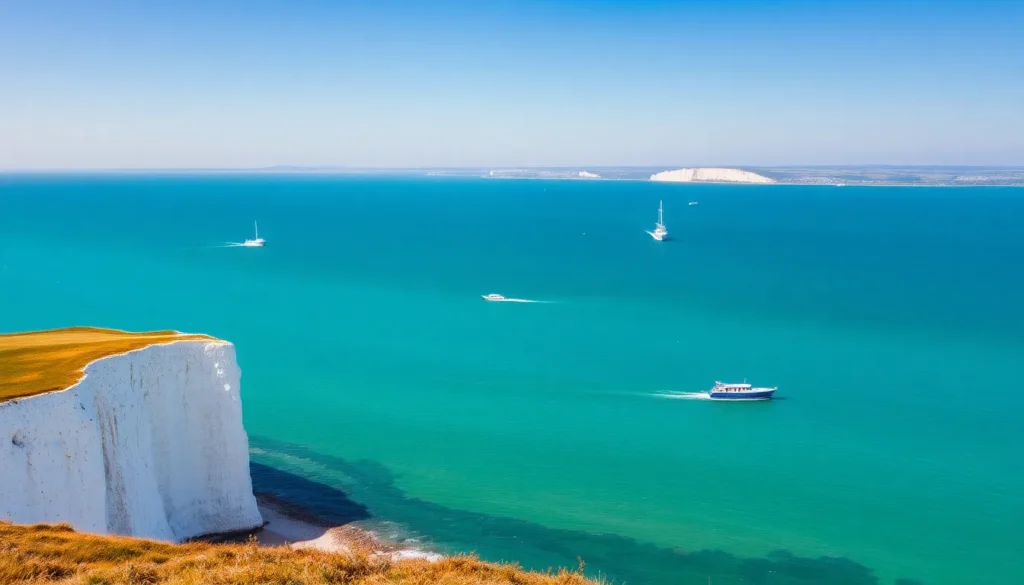Table of Contents
ToggleThe English Channel, a vital waterway separating England from continental Europe, has long captured the imagination of explorers, swimmers, and historians alike. Stretching between Dover in England and Calais in France, this iconic channel serves as a gateway for trade and travel while also presenting a formidable challenge for those daring enough to cross its waters.
Understanding the exact length of the English Channel isn’t just a matter of geography; it’s a topic that intertwines with maritime history and human endeavor. As one of the world’s busiest shipping lanes, its dimensions play a crucial role in navigation and transportation. In this article, we’ll explore how long the English Channel is, delving into its significance and the factors that define its boundaries.
Overview of the English Channel
The English Channel, also known as La Manche, serves as a critical waterway between England and France. Stretching approximately 21 miles (34 kilometers) at its narrowest point between Dover and Calais, the channel connects the North Sea to the Atlantic Ocean. Mariners and historians recognize its strategic significance in facilitating maritime trade and travel.
The channel’s depth varies, with some areas reaching about 180 feet (55 meters) and others shallower, presenting both opportunities and challenges for navigation. Its currents and tides can be strong, impacting vessels crossing its expanse. Furthermore, the English Channel has inspired countless adventurers, with numerous attempts documented for swimming across its waters.
The channel’s impact on regional culture is notable, influencing shipping routes, naval history, and international relations. The robust infrastructure for ferry services and the Channel Tunnel underscores its role as a vital transportation link. Understanding the geographical dimensions of the English Channel reveals its importance beyond mere distance, shaping historical and contemporary interactions between nations.
Geographic Location

The English Channel, a vital waterway, connects England to continental Europe. Its geographical positioning plays a crucial role in trade and cultural exchange.
Countries Bordering the Channel
- United Kingdom: The channel’s northern border, comprising England and a small portion of France.
- France: The southern border, marked by various regions, including Normandy.
- Islands: The channel also surrounds several islands, such as the Isle of Wight in England and the Channel Islands, which lie closer to France.
Major Cities Along the Coast
- Dover: Located in England, this city serves as a primary port and starting point for crossings to France.
- Calais: A significant French port city, it provides vital ferry services and links to the UK.
- Boulogne-sur-Mer: Another French city, known for its fishing industry and proximity to the English Channel.
- Brighton: This English coastal city offers a popular beach and cultural attractions, enhancing maritime tourism.
Length of the English Channel
The English Channel, measuring approximately 21 miles (34 kilometers) at its narrowest point, demonstrates significant geographic dimensions crucial for maritime navigation and trade. Its strategic location contributes to its historical and contemporary relevance.
Measurement Methods
The length of the English Channel is primarily determined using nautical charts and modern surveying techniques. Hydrographic surveys employ satellite positioning and sonar mapping to create accurate representations of the channel’s depth and width. Maritime authorities, such as the UK’s Hydrographic Office, provide official measurements based on these technologies, ensuring precise navigation data for vessels.
Variations in Length
Variations in length exist due to the English Channel’s geographical features and fluctuating tides. The narrowest point, between Dover and Calais, holds the classic distance of 21 miles, whereas other stretches, such as the western section toward the Isles of Scilly, can expand measured distances significantly. Additionally, tides can affect how the distance appears, impacting navigation and travel times for ships traversing the channel.
Historical Significance
The English Channel has shaped significant historical narratives, impacting trade, migration, and military strategy. Its role as a vital maritime route offers insights into the region’s past and its influence on modern society.
Channel Crossings Through History
Channel crossings date back to ancient times, serving as a critical way for commerce and cultural exchange. The Romans crossed the channel around 40 AD, solidifying trade routes between Britain and continental Europe. During the Middle Ages, the passage became crucial for pilgrims traveling to the shrine of Thomas Becket in Canterbury. The 19th century saw a surge in crossings with the advent of steamships, facilitating tourism and migration. Today, thousands cross daily via ferries and the Channel Tunnel, reinforcing its importance in contemporary travel.
Role in World Events
The English Channel has been at the center of numerous historical events, emphasizing its strategic military significance. During World War II, the channel acted as a barrier for Nazi Germany, while the D-Day landings in June 1944 showcased its role as a launch point for Allied forces. The channel’s control impacts naval power and international relations, influencing military strategies throughout history, including the Napoleonic Wars and the Falklands Conflict. Its continuous relevance to geopolitical dynamics reflects the channel’s enduring historical significance.
Modern Importance
The English Channel plays a critical role in contemporary transportation, trade, and tourism, serving as a major conduit for goods and travelers alike. Its significance extends beyond mere geography, influencing numerous sectors in both the United Kingdom and France.
Transportation and Trade Routes
The English Channel forms a vital transportation link for international trade, accommodating an estimated 300 ferries daily. Major ferry operators include DFDS and P&O Ferries, facilitating freight transport and passenger crossings between the UK and France. The Channel Tunnel, stretching approximately 31.4 miles (50.5 kilometers), provides a high-speed rail connection for both vehicles and passengers, enhancing trade efficiency. In 2022, over 28 million passengers crossed through the tunnel, showcasing its importance in travel and commerce. The channel also supports significant shipping routes, with container ships navigating through its waters, connecting European ports to global markets.
Tourism and Recreation
Tourism along the English Channel remains a significant driver of local economies. Popular destinations include Dover, known for its iconic white cliffs and historical landmarks, and Calais, celebrated for its shopping and culture. Approximately 17 million visitors travel between the UK and France each year, using ferry services for day trips and extended vacations. Recreational activities thrive in the channel’s waters, drawing swimmers, sailors, and divers. Events like the annual Swim the Channel challenge attract participants from around the world, highlighting the channel’s allure and promoting active tourism. In 2022, around 800 individuals successfully completed the swim, further underscoring the channel’s recreational significance.
The English Channel stands as a vital waterway that has shaped trade and cultural exchange between England and France for centuries. Its impressive length of approximately 21 miles at its narrowest point highlights its significance in navigation and maritime history. The channel’s challenges and allure continue to attract adventurers and tourists alike, while its robust infrastructure supports a bustling transportation network. As it remains a crucial link in global trade and tourism, the English Channel will undoubtedly continue to play an essential role in connecting nations and fostering economic growth for years to come.




